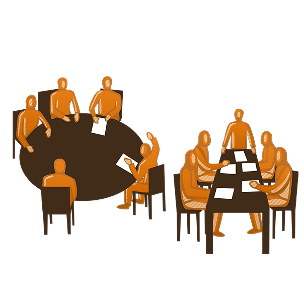Well-designed meeting processes are often the difference between productive teamwork and wasted time. Meeting processes are a key driver of team effectiveness. They provide the structure teams need to communicate clearly, make decisions efficiently, and follow through on commitments.
Strong teams don’t just meet frequently. They meet well. Their meetings are focused, organized, and aligned to the team’s priorities. Without strong meeting processes, even highly aligned and well-structured teams can stall out.
At KSE Leadership, we define meeting processes as designing procedures that pave the way for effective and efficient meetings. Based on our research and experience, six practices consistently show up on high-performing teams:

Assign someone to guide and manage segments of meetings
Facilitation matters. Effective teams designate someone to lead or manage each part of the meeting. This helps keep discussions focused, ensures balanced participation, and allows for smoother transitions between topics. It also avoids the problem of meetings being dominated by the most vocal team members.
Meet often enough to do the work of this team
There’s no universal rule for how often to meet, but frequency should match the team’s level of interdependence and workload. High-performing teams make time to meet as often as their goals require. They adjust cadence based on the pace of decision-making and the complexity of their work.
Use pre-read materials for important topics
Preparation increases meeting quality. Teams that use pre-read materials ensure participants come ready to engage. This leads to deeper, more informed discussions. It also respects people’s time by keeping meetings focused on dialogue and decision-making instead of passive information sharing.
Track action items and decisions made
Decisions and actions must not disappear after the meeting ends. Effective teams keep track of what was decided, who is responsible, and what the follow-up is. This builds accountability and ensures momentum between meetings. Without this step, meetings lose impact.
Use agendas skillfully for our meetings on the most important things
A good agenda does more than list topics. It prioritizes what matters most, allocates time intentionally, and sets expectations for outcomes. Effective teams build agendas that guide the conversation and reinforce strategic focus. They also leave space for emerging issues that need real-time attention.
Have an effective decision-making process
Meetings are where key decisions happen. Teams need clarity on how decisions are made—whether by consensus, majority, or a designated decision-maker. They also need alignment on when input is being gathered and when a decision is final. Clear decision-making processes reduce confusion and prevent rework.
Meeting Processes as a Driver of Team Effectiveness
Meeting processes are one of four critical drivers of team effectiveness, alongside team assembly, team alignment, and team dynamics. Even a well-assembled and well-aligned team will struggle if their meetings lack structure and purpose.
As you evaluate your own team’s effectiveness, ask whether your meetings drive progress or just consume time. Improving your meeting processes is one of the most practical ways to strengthen team performance—and one of the easiest to overlook.
In our next post, we’ll explore the final driver: team dynamics. We’ll look at how interpersonal behaviors and group norms impact trust, collaboration, and performance.
Want a Fast Way to Improve Executive Team Effectiveness?
Executive team effectiveness is not just about individual talent. It’s about how the team operates when stakes are high and time is tight. If you’re looking for a fast, focused way to understand how your team is really doing, reach out about our Team Effectiveness Profile (TEP). It’s a simple tool that gives you immediate insight into what’s working, what’s not, and where to focus next.
If your executive team is aiming to reach the next level of performance, we can help. At KSE Leadership, we work with senior teams to strengthen trust, sharpen execution, and improve how leaders work together. Whether you’re navigating change or preparing for growth, we’ll help you build the habits that drive lasting executive team effectiveness.


Comments are closed for this article!